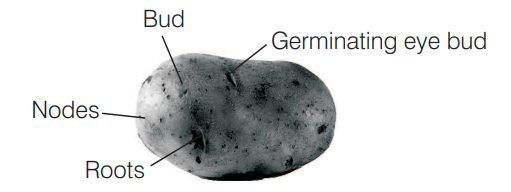Mention two inherent characteristics of Amoeba and yeast that enable them to reproduce asexually.
The characteristics that enable Amoeba and yeast to reproduce asexually, are as follows
(i) Unicellularity
(ii) Simple body organisation
(iii) Uniparental condition
Why do we refer to offspring formed by asexual method of reproduction as clones?
The reproduction is called asexual, when offspring is produced by a single parent with or without the involvement of gamete formation.
As a result, the offspring that are produced are not only similar to one another, but are also exact copies of their parent. Such a group of morphologically and genetically similar individuals is called clone.
Although potato tuber is an underground part, it is considered as a stem. Give two reasons.
Potato tuber is considered as a stem because of the following reasons
 (i) The tuber has nodes and internodes.
(i) The tuber has nodes and internodes.
(ii) Leafy shoots appear from the nodes.
Between an annual and a perennial plant, which one has a shorter juvenile phase? Give one reason.
In a lifespan, the organism has to grow and develop (the juvenile phase). After that the organism mature sexually and enter into the reproductive phase, before it undergoes senescence followed by death.
Since, the entire life cycle of an annual plant is shorter and has to be completed in one growing season, its juvenile phase is shorter than that of a perennial plant.
Rearrange the following events of sexual reproduction in the sequence in which they occur in a flowering plant embryogenesis, fertilisation, gametogenesis, pollination.
The correct sequence of events of sexual reproduction in a flowering plant are as follows gametogenesis, pollination, fertilisation, embryogenesis.